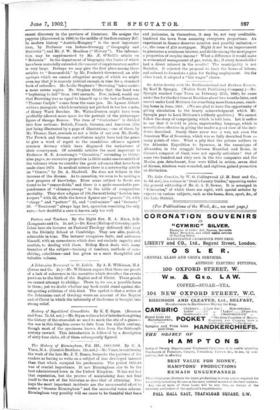SOME BOOKS OF THE WEEK.
[Under this heading we notice such Books of the week as have not been reserved for review in other forms.]
Eneyclopredia Britannica. Supplementary VoL II. (A. and C. Black.)—Professor Sayce contributes an important article on "Babylonia and Assyria." In Babylonian exploration much has been done, the lead having been taken by the University of Pennsylvania at Niffer (Nippur). The general result has been to carry back Babylonian chronology to a very remote period, not later than 4000 B.C., as well as to illuminate more recent times. Nowhere has research been more fruitful, and this in the region of daily life as well as of history. From Sir R. C. Jebb we have an admirable criticism of Bacchylides, a name which represents recent discovery in the province of literature. He assigns the papyrus (discovered in 1896) to the middle of the first century B.C. In modern history " Austria-Hungary " is the most important item, by Professor von Indura-Sternegg (" Geography and Statistics") and Mr. J. W. Headlam (" History"). The informa- tion may be supplemented by Mr. IE. O'Neill's article on " Bohemia." In the department of biography, the limits of which have been materially extended, the amount of supplementary matter is very large. Perhaps we may give the first place among these articles to "Beaconsfield," by Mr. Frederick Greenwood, an able apologia which we cannot altogether accept, of which we might even say that it is scarcely judicial enough in tone for a standard book of reference. Mr. Leslie Stephen's "Browning " takes us into a more serene region. Mr. Stephen thinks that the hand was " beginning to fail " from 1883 onwards. Few, indeed, would say that Browning was as equal to himself up to the last as Tennyson. " Thomas Carlyle " comes from the same pen. Mr. Lyman Abbott writes a panegyric, which is certainly not pitched in too low a note, of Henry Ward Beecher. Mr. Watts-Dunton might have been profitably allowed more space for his portrait of the picturesque figure of George Borrow. The item of "Caricature" is divided into four sections : British, French, German, and American (the last being illustrated by a page of illustrations,—one of these, by Mr. Thomas Nast, reminds us not a little of our own Mr. Reed). The French and German contributors might have had the grace to give a word of regret to the scandalous offences against common decency which have disgraced the caricatures of their countrymen. Of scientific articles the most important is Professor H. E. Armstrong's "Chemistry," extending to thirty- nine pages, no excessive proportion (a little under one-twentieth of the volume) when we consider the great advances that have been made since 1874. In medical science there is a noteworthy article on "Cancer," by Dr. A. Shadwell. He does not believe in the increase of the disease. As to causation, we seem to be making a slow progress of knowledge. River areas subject to floods are found to be "cancer-fields," and there is a quite remarkable pre- ponderance of " chimney-sweeps " in the table of comparative mortality. They show a figure of 156, the next being "London inn- keepers" with 50, while the lowest figures are "grocers" 34, with "clergy" and "potters" 35, and "coal-miners" and " farmers " 36. " Treatment " always lags last, operation remaining the only cure,—how doubtful a cure is known only too well.







































 Previous page
Previous page